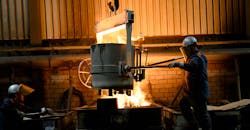Research Project Targets Hydrogen-Powered Crucible Melting
A German metalcaster, G.A. Röders in Soltau, is at work as part of a consortium to develop a hydrogen-powered crucible furnace for melting aluminum alloys. “For Röders, it is one of the most interesting research projects in recent years and we hope to no longer be dependent on gas in a few years,” according to Gerd Röders, co-managing director of the aluminum and zinc diecasting manufacturer.
G.A. Röders GmbH & Co. KG was founded in 1814 and now is operating under the sixth generation of family ownership.
Germany’s Ministry of Economics and Climate Protection is supporting the hydrogen crucible research, and the metalcaster will receive €140,000 from the overall, €3-million program budget. To this, G.A. Röders has committed to contribute another €150,000.
Hydrogen, of course, is the object of numerous efforts to address industrial carbon-dioxide emissions, because the only airborne byproduct of hydrogen combustion is water vapor. Hydrogen has occupied the attention of steelmakers for the past several years as they strive to address CO2 emissions from blast furnaces – using H2 instead of coal as a reducing agent in the production of molten iron. The output of this process could be charged while still hot into a basic oxygen or electric melting furnace, or processed into briquettes or pellets for cold charging.
Crucible melting is a general term for processes that involve smaller volumes of metal alloys, using a refractory crucible that is heated by conduction to liquify the charge. Various fuels may be used, including coke, oil, different gases, or electricity.
Foundries and diecasters, of course, operate on a different industrial scale than steelmakers – and with various metal alloys. But, like steelmakers, metalcasters are under some regulatory pressure as well as investor-led scrutiny to reduce the carbon emissions of their operations. G.A. Röders claims to be consistently pursuing “sustainability,” citing for example its own certified energy-management system, including solar power generation and sourcing of only “green electricity” for its German foundries. The company also pays a voluntary offset fee for CO2 produced by its use of oxygen fuel for melting aluminum.
There are financial considerations too, and co-managing director Andreas Röders confirmed that the business is mindful of rising fuel costs for operating it diecasting and injection-molding plants.
“For our three sites in Germany and the Czech Republic, energy costs will increase by more than two million euros in 2022,” Andreas Röders said. “It will be difficult to pass these additional costs on to our customers, as they are often large corporations in the automotive and aviation industries.”
He continued: “The announced support for the energy-intensive industry in the transition from fossil to renewable energy is urgently needed. Otherwise, thousands of jobs and the associated know-how will disappear from Germany forever. For us, energy prices pose an even greater existential threat than the Corona pandemic.”
The Röders’ commitment to the hydrogen melting research is being done through the Institute for Welding Technology at the University of Braunschweig, Germany, which operates a light-metal research foundry with a 250-kg crucible furnace, dosing and degassing systems, and a cold-chamber diecasting machine.
Also participating in the research is Bohai Trimet Automotive, an aluminum diecasting business with plants in Germany and China; ChemTrend, a manufacturer of mold-release agents and other industrial chemicals; Netco Professionals, which develops industrial monitoring and body-cam technologies; and Neo Hydrogen Sensors – which is developing and will manufacture the hydrogen burner to be used in the new crucible.
Apart from the development of the new hydrogen melting capability, all the other energy consumption and the CO2 footprint of the process will be defined and optimized according with the help of artificial intelligence.
“With the hydrogen-powered furnace, we at G.A. Röders want to become pioneers in our industry for climate protection,” the Röders brothers stated.
